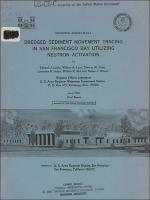Please use this identifier to cite or link to this item:
https://hdl.handle.net/11681/6805| Title: | Dredged sediment movement tracing in San Francisco Bay utilizing neutron activation |
| Authors: | United States. Army. Corps of Engineers. San Francisco District Leahy, Edward J. Lane, William B. Tami, Thomas M. Inman, Lawrence B. McLoud, William R. Adams, Nolan J. |
| Keywords: | Dredged material Neutrons Ocean waste disposal San Francisco Bay Sediment analysis Sediment transport Tracers |
| Publisher: | Weapons Effects Laboratory (U.S.) Engineer Research and Development Center (U.S.) |
| Series/Report no.: | Technical report (U.S. Army Engineer Waterways Experiment Station) ; N-76-1. |
| Description: | Technical report Abtract: The U. S. Army Engineer District, San Francisco, in 1973, initiated a study of the environmental impacts of dredging and aquatic disposal operations in San Francisco Bay. One part of this study was a program to determine the movement and recirculation of dredged materials after their aquatic disposal. The movement and circulation of sediments in San Francisco Bay result from the complex interactions of tidal flows, wind-wave resuspension and loads, stratification, and shifting of nodal point. This complex system is currently beyond the modeling capability of mathematical and physical hydraulic models. Thus, a program was instituted to physically trace the movement of dredged materials with the objective of quantifying the horizontal and vertical recirculation of the dredged sediment. Tracing was accomplished by tagging Bay sediments with the chemical element iridium, neutron-activating sediment samples collected from an extensive test area, and using gamma-ray spectrometry to determine the quantity of iridium and hence the amount of dredged material present. This report describes the research efforts conducted to (a) identify the chemical elements suitable for use as neutron-activable tracers, (b) tag the San Francisco Bay sediments, (c) introduce the tagged mineral particles into the dredged material, and (d) analyze the collected sediment samples. Interpretation of the sediment samples in terms of sediment circulation and shoaling is the subject of a separate report to be published by the San Francisco District. A complete listing of all data collected during the March-December 1974 sampling of San Francisco Bay is contained in Appendix A, which is published under separate cover. Copies may be requested from the U. S. Army Engineer Waterways Experiment Station Technical Information Center. The program was successful and permitted tracing the movement of the dredged material for a period of 10 months after the introduction of traced sediments in February-March 1974 until the completion of sampling in December 1974. The Tracer Program showed that material dredged from Mare Island Strait and released at the Carquinez Strait disposal site is distributed both spatially and with depth in bottom sediments over most of the region sampled. Initial dispersion is fast and resuspension seems to occur continuously. A portion of the dredged material is transported back to the original dredged channel. Upon redredging of the channel in September 1974, the traced sediments from the original tracing operation were detected in the study area. A general conclusion is that the movement of dredged sediments is probably more complex than originally anticipated. One definite conclusion can be drawn from the overall results of the San Francisco Bay Tracer Program. The technique for tagging material with an inert chemical element, neutron-activating the field samples, and using gamma-ray spectrometry to determine the quantity of tracer material was successfully proven. Although somewhat expensive, iridium was found to be the most cost-effective chemical element for tagging and tracing sediments for the particular set of conditions existing in San Francisco Bay. With the neutron activation process, however, other chemical elements can definitely be used and may be more cost-effective for tracing dredged sediments in other locations. |
| Rights: | Approved for public release; distribution is unlimited. |
| URI: | http://hdl.handle.net/11681/6805 |
| Appears in Collections: | Technical Report |
Files in This Item:
| File | Description | Size | Format | |
|---|---|---|---|---|
| TR-N-76-1.pdf | 4.28 MB | Adobe PDF |  View/Open |